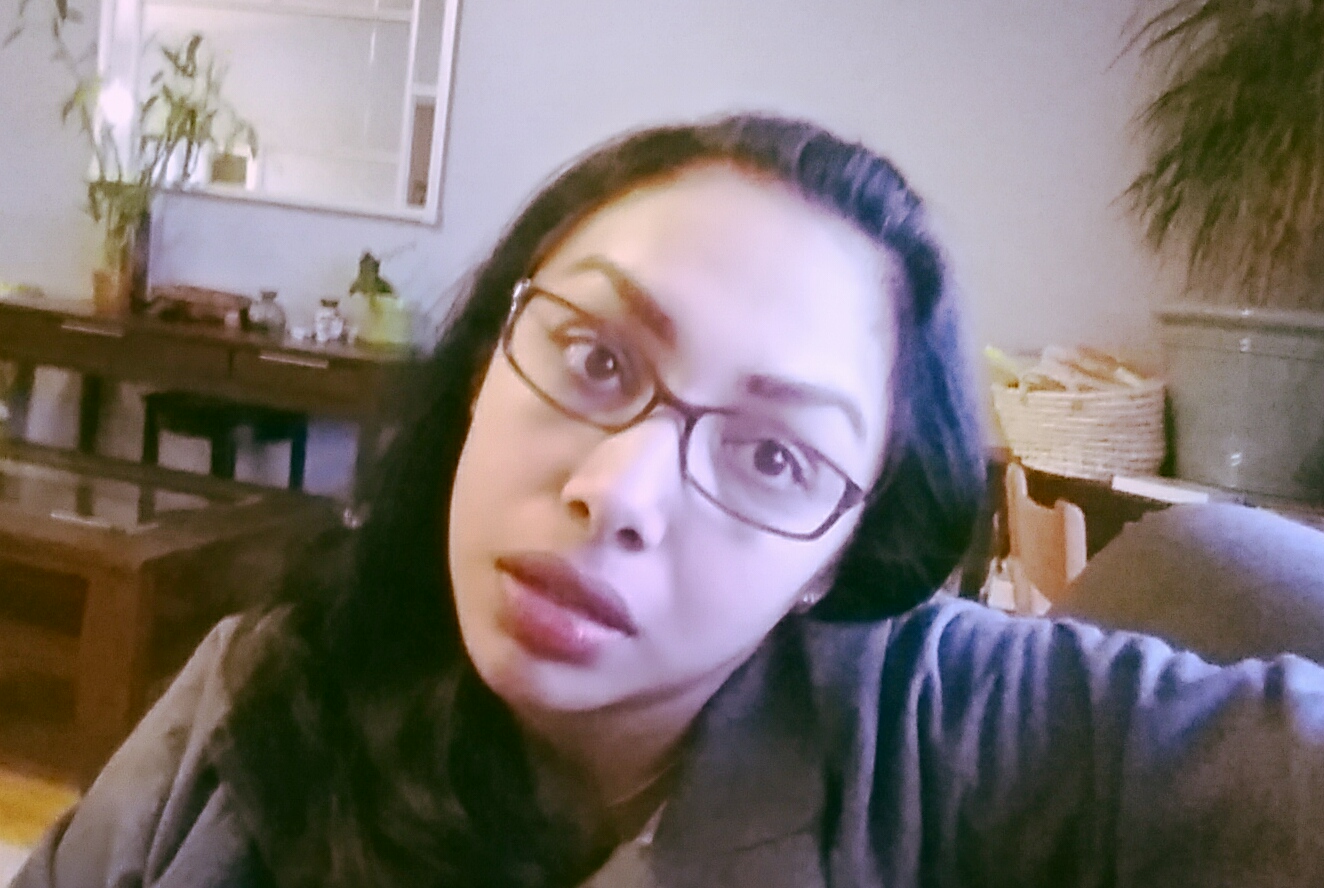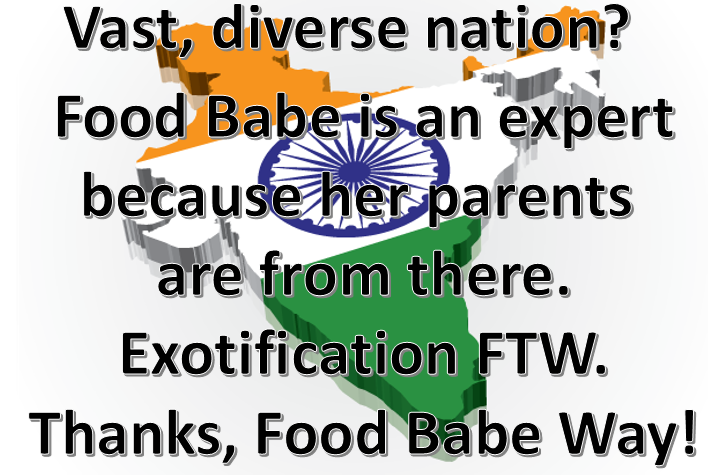Kavin Can’t Even: Food Babe Way Exotifies India, and Grossly Exaggerates or Lies About Her Dad

Dear Vani,
Your exotification of India, and simultaneous painting of the nation as full of people who can only afford cheap food is offensive. As an Indian-American, I’m appalled and disgusted by your frequent “appeals to India” in your new book “The Food Babe Way.” There is so much this-is-how-my-ancestors did it, this-is-how-all-Indians live and eat rhetoric. This is no better than a ploy to make your “way” seem exotic, Eastern, and therefore good. For example in chapter four you state,
“For thousands of years, my ancestors in India had one cow that they shared with the rest of the villagers.”
Oh, how charming. Gag me with a finger (Indians don’t use spoons, don’t you know? /s.) Vani, you’re generalizing and fallaciously homogenizing a vast country populated by over a billion diverse people. You go on to blather,
“Indian immigrants and other immigrants from raw-milk-producing countries are being duped by the US dairy industry and don’t even know it. I’d really like to see my family recipes passed down from generation to generation, but I’m not sure we can do this safely for our future children and grandchildren unless we can all get access to real raw milk.”
Are you really trying to tell me that Indian recipes call only for raw milk? Purely anecdotal here, but my mom makes perfectly delicious and authentic Indian dishes with regular, pasteurized American yogurt, milk, and buttermilk and no, she doesn’t buy organic milk. But I’m sure your sad little lament about not being able to pass your family’s traditions to your descendants is really moving to the average, unsuspecting American.

You repeatedly make these “appeals to India.” Here, you either grossly exaggerate or lie about your father:
“My dad has always liked fast food because it’s cheap, and that’s why he fed us at fast food restaurants when we were kids…Growing up in India, he was brought up to believe that food’s sole purpose was to keep you alive, and you never wasted food. Buying food cheap was the only way to get it. After moving to the United States, he mostly subsisted on fast food because it was a good buy. Sadly, this reasoning meant that my dad never paid attention to the nutritional value of good food. Over time, he developed type 2 diabetes.”
-Food Babe Way, Chapter 5
Guess what? Not everyone in “growing up in India” is brought up the same way. Not everyone who grew up in India is naïve enough to think it’s a good idea to subsist on fast food because “it’s a good buy.” A typical Indian diet isn’t significantly more expensive to cook than buying fast food every meal. Indians non-vegetarians only eat meat once or twice a week, and consume a diet high in vegetables and lentils. I assure you, my mom fed her whole family a nutritious Indian meal every night on a low grocery budget.
Here’s where your story doesn’t add up. In your Experience Life interview, you state:
“Actually, my dad wanted us to fit into the American lifestyle, so my brother and I were never required to eat the Indian food my mom cooked. She would cook one meal for herself and my dad — gourmet, Indian, from scratch, full of spices and vegetables from her garden — which to me looked weird and gross. And for us kids, she relied on processed foods: microwavable Salisbury steak, mozzarella sticks, chicken tenders, and all that stuff that came in a box from the frozen section. McDonald’s and Burger King and Wendy’s. Really, we were allowed to eat whatever we wanted, to fit in with the world around us.”
So what was it, did your dad subsist primarily on fast food, or eat homemade, fresh Indian meals? It seems to me that you weren’t quite honest one of these two times. If I’m wrong, please explain how.
Additionally, you clearly have no idea about the complexity of type 2 diabetes, especially among the Indian population. Would you know what I mean if I said that the genotype of type 2 diabetes is believed by scientists to be different from that of the western population despite similar phenotype/clinical presentation? That non-overweight Indians are more prone to developing type 2 diabetes despite healthy diets and active lifestyles than their western counterparts? I think not. But I digress. I can’t imagine what other drivel the rest of your book spouts about India. I’ve only read five chapters of Food Babe Way, and I’m not sure how much more I can take…..
Incredulously,
Kavin
Note: If you share this piece, please use hashtag #kavincanteven. Read more in the Kavin Can’t Even series here. Thanks!
Featured image © 2015 Kavin Senapathy





This whole thing about Indians using raw milk is totally baffling to me. I grew up in Kerala and had cows or goats most of the time. One thing we never do is drink raw milk. My grandmother was so adamant that the milk should be cooked, not just boiled before consuming. While I have had milk directly put into my mouth straight from the cows udder (well, once, and survived. Not an easy feat to do squatting under the cow) that was considered to be a very stupid thing to do.
I have never seen anyone in my experience in Kerala even consider drinking raw milk. Of course, this is my experience from middle/south Kerala. Things could be different somewhere else. For sure, India is quite diverse.
salim-nair – I’m sure things are different in certain pockets of India, as they may be worldwide. But any part of India that has modern amenities, as traditional as they may be, would either home-pasteurize their milk, or purchase pasteurized milk. When I took my firstborn child to India as a toddler, my family purchased already-pasteurized milk and boiled it again for good measure. I was born in the US, but grew up visiting India every 3-4 y ears, and they always boiled the milk, even after it became widely available in pasteurized form. Most of my mom’s side lives in Tamil Nadu. Most of my father’s side emigrated from India to the U.S. in the 80s and 90s….
Is it possible that Food Babe doesn’t know that pasteurization is just boiling? She never said how the raw milk was treated. Maybe her family boiled the crap out of it and she just doesn’t know what the word “pasteurized” means
Well, she already admitted she can’t tell propylene glycol (which she calls ‘antifreeze’ because it’s an ingredient in antifreeze, never mind there are other ingredients which make it toxic) from propylene glycol alginate. Like, reading Food Babe is like fighting a hydra of wrong.
Actually Kavin, I’ve travelled all over India (Military father), and let me assure you, in every village I visited, from north to south, from Amritsar to Manepally, milk is boiled before consumption. Absolutely everywhere, unless you drink it straight from the udder, while it’s still relatively fresh.
And to any AMericans reading this, sorry guys, we messed up. Just bag-and-tag Vani Hari so that we can put her back in the asylum she escaped from…
I get more and more confused by her by the minute. She was one of those demanding that Starbucks go to organic milk right? And she pushes organic products everywhere else. Does she know that raw milk is basically the opposite of organic milk which is ultra pasteurized?
Heh. I can’t speak to Indian cultural foodways. Ironically, though, in grad school and meeting all those Indian students I developed a serious Indian food habit.
I come from people who knew famine. My ancestors left Ireland because hunger. We have crap for food traditions. But nobody seemed to fall for food fads much. One of grandma’s favorite phrases was, ‘I’m so hungry I’d eat the asshole out of a cat.” Yet, we don’t have diabetes in our family. So, there’s that. Let’s have cat.
But as to American nostalgia for food–one time I was reading about the Ingalls girls as grownups (for folks who didn’t grow up with the books and TV show, that’s the Little House on the Prairie family). Turns out they all had diabetes. Go figure.
“It seems to me that you weren’t quite honest one of these two times.”
Kavin, you are way nicer and more generous in your interpretation than she deserves. Most likely it is all a pack of lies, made up to suit whatever need she had at the moment she said it. It’s worked for her so far, after all, so why not?
Thank you for a great retort to the Fewd Baby. As a first generation Canadian (European heritage) I also had a similar story but different context. After my parents immigrated to Canada they kept many of their culinary habits but also embraced others. Many of our family friends were also recent immigrants. Sharing their foods and culture was wonderful. Some of my fondest memories are dinner nights at one of the East Indian families. The curries and other treats were wonderful, including a homemade yoghurt from you guessed it pasturized milk.
My mother also raised us on raw milk from a neighboring dairy farm and would make quark (a German type of cottage cheese). The exotification and Columbusing of foods and diets is Woo at its finest.